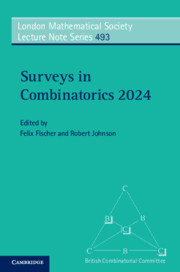Book contents
- Frontmatter
- Contents
- Preface
- Intersection Theory of Matroids: Variations on a Theme
- Erdős Covering Systems
- The Cluster Expansion in Combinatorics
- Sublinear Expanders and Their Applications
- Transversals in Latin Squares
- Finite Field Models in Arithmetic Combinatorics – Twenty Years On
- The Slice Rank Polynomial Method – A Survey a Few Years Later
- An Introduction to Transshipments Over Time
- Oriented Trees and Paths in Digraphs
- References
Oriented Trees and Paths in Digraphs
Published online by Cambridge University Press: 23 May 2024
- Frontmatter
- Contents
- Preface
- Intersection Theory of Matroids: Variations on a Theme
- Erdős Covering Systems
- The Cluster Expansion in Combinatorics
- Sublinear Expanders and Their Applications
- Transversals in Latin Squares
- Finite Field Models in Arithmetic Combinatorics – Twenty Years On
- The Slice Rank Polynomial Method – A Survey a Few Years Later
- An Introduction to Transshipments Over Time
- Oriented Trees and Paths in Digraphs
- References
Summary
Which conditions ensure that a digraph contains all oriented paths of some given length, or even a all oriented trees of some given size, as a subgraph? One possible condition could be that the host digraph is a tournament of a certain order. In arbitrary digraphs and oriented graphs, conditions on the chromatic number, on the edge density, on the minimum outdegree and on the minimum semidegree have been proposed. In this survey, we review the known results, and highlight some open questions in the area.
Information
- Type
- Chapter
- Information
- Surveys in Combinatorics 2024 , pp. 271 - 295Publisher: Cambridge University PressPrint publication year: 2024
References
Accessibility standard: Unknown
Why this information is here
This section outlines the accessibility features of this content - including support for screen readers, full keyboard navigation and high-contrast display options. This may not be relevant for you.Accessibility Information
- 1
- Cited by
